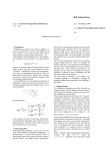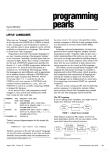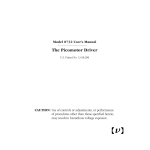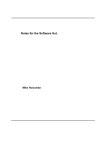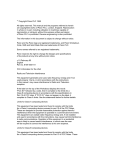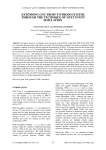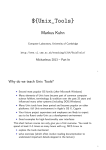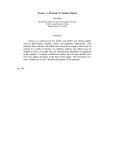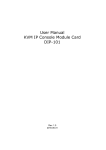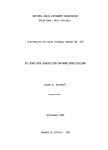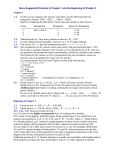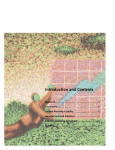Download UNIX Version 7 Volume 2A
Transcript
A System for Typesetting Mathematics
Brian W. Kernighan and Lorinda L. Cherry
Bell Laboratories
Murray Hill, New Jersey 07974
ABSTRACT
This paper describes the design and implementation of a system for typesetting mathematics. The language has been designed to be easy to learn and to use by people (for example,
secretaries and mathematical typists) who know neither mathematics nor typesetting. Experience
indicates that the language can be learned in an hour or so, for it has few rules and fewer exceptions. For typical expressions, the size and font changes, positioning, line drawing, and the like
necessary to print according to mathematical conventions are all done automatically. For example, the input
sum from i=0 to infinity x sub i = pi over 2
produces
∞
π
Σxi = _2_
i =0
The syntax of the language is specified by a small context-free grammar; a compilercompiler is used to make a compiler that translates this language into typesetting commands.
Output may be produced on either a phototypesetter or on a terminal with forward and reverse
half-line motions. The system interfaces directly with text formatting programs, so mixtures of
text and mathematics may be handled simply.
This paper is a revision of a paper originally published in CACM, March, 1975.
1. Introduction
‘‘Mathematics is known in the trade as
difficult, or penalty, copy because it is slower, more
difficult, and more expensive to set in type than any
other kind of copy normally occurring in books and
journals.’’ [1]
One difficulty with mathematical text is the
multiplicity of characters, sizes, and fonts. An
expression such as
lim (tan x )sin 2x = 1
x →π⁄2
requires an intimate mixture of roman, italic and
greek letters, in three sizes, and a special character or
two. (‘‘Requires’’ is perhaps the wrong word, but
mathematics has its own typographical conventions
which are quite different from those of ordinary text.)
Typesetting such an expression by traditional methods
is still an essentially manual operation.
A second difficulty is the two dimensional
character of mathematics, which the superscript and
limits in the preceding example showed in its simplest
form. This is carried further by
b1
a 0+ ________________
b2
a 1+ ____________
b3
a 2+ ________
a 3+ . . .
and still further by
a emx −√
b
1
_√_________
_______ log
mx
b
+√
2m
√
a
b
√
ae
dx
√a emx
1
__________
= ______ tanh−1( ____
)
∫ _ae
mx
−be −mx
√
b
m
√
ab
−1
√a emx
______
coth−1( ____
)
m √
ab
√b
These examples also show line-drawing, built-up
characters like braces and radicals, and a spectrum of
positioning problems. (Section 6 shows what a user
has to type to produce these on our system.)
-2-
2. Photocomposition
Photocomposition techniques can be used to
solve some of the problems of typesetting mathematics. A phototypesetter is a device which exposes a
piece of photographic paper or film, placing characters wherever they are wanted. The Graphic Systems
phototypesetter[2] on the UNIX operating system[3]
works by shining light through a character stencil.
The character is made the right size by lenses, and
the light beam directed by fiber optics to the desired
place on a piece of photographic paper. The exposed
paper is developed and typically used in some form
of photo-offset reproduction.
On UNIX, the phototypesetter is driven by a
formatting program called TROFF [4]. TROFF was
designed for setting running text. It also provides all
of the facilities that one needs for doing mathematics,
such as arbitrary horizontal and vertical motions,
line-drawing, size changing, but the syntax for
describing these special operations is difficult to learn,
and difficult even for experienced users to type
correctly.
For this reason we decided to use TROFF as an
‘‘assembly language,’’ by designing a language for
describing mathematical expressions, and compiling it
into TROFF.
3. Language Design
The fundamental principle upon which we
based our language design is that the language should
be easy to use by people (for example, secretaries)
who know neither mathematics nor typesetting.
This principle implies several things. First,
‘‘normal’’ mathematical conventions about operator
precedence, parentheses, and the like cannot be used,
for to give special meaning to such characters means
that the user has to understand what he or she is typing. Thus the language should not assume, for
instance, that parentheses are always balanced, for
they are not in the half-open interval (a ,b ]. Nor
should it assume that that √
a +b can be replaced by
1
(a +b ) ⁄ , or that 1⁄(1−x ) is better written as ____ (or
1−x
vice versa).
1
2
Second, there should be relatively few rules,
keywords, special symbols and operators, and the
like. This keeps the language easy to learn and
remember. Furthermore, there should be few exceptions to the rules that do exist: if something works in
one situation, it should work everywhere. If a variable can have a subscript, then a subscript can have a
subscript, and so on without limit.
Third, ‘‘standard’’ things should happen
automatically. Someone who types ‘‘x=y+z+1’’
should get ‘‘x =y +z +1’’. Subscripts and superscripts
should automatically be printed in an appropriately
smaller size, with no special intervention. Fraction
bars have to be made the right length and positioned
at the right height. And so on. Indeed a mechanism
for overriding default actions has to exist, but its
application is the exception, not the rule.
We assume that the typist has a reasonable picture (a two-dimensional representation) of the desired
final form, as might be handwritten by the author of a
paper. We also assume that the input is typed on a
computer terminal much like an ordinary typewriter.
This implies an input alphabet of perhaps 100 characters, none of them special.
A secondary, but still important, goal in our
design was that the system should be easy to implement, since neither of the authors had any desire to
make a long-term project of it. Since our design was
not firm, it was also necessary that the program be
easy to change at any time.
To make the program easy to build and to
change, and to guarantee regularity (‘‘it should work
everywhere’’), the language is defined by a contextfree grammar, described in Section 5. The compiler
for the language was built using a compiler-compiler.
A priori, the grammar/compiler-compiler
approach seemed the right thing to do. Our subsequent experience leads us to believe that any other
course would have been folly. The original language
was designed in a few days. Construction of a working system sufficient to try significant examples
required perhaps a person-month. Since then, we
have spent a modest amount of additional time over
several years tuning, adding facilities, and occasionally changing the language as users make criticisms
and suggestions.
We also decided quite early that we would let
TROFF do our work for us whenever possible.
TROFF is quite a powerful program, with a macro
facility, text and arithmetic variables, numerical computation and testing, and conditional branching. Thus
we have been able to avoid writing a lot of mundane
but tricky software. For example, we store no text
strings, but simply pass them on to TROFF. Thus we
avoid having to write a storage management package.
Furthermore, we have been able to isolate ourselves
from most details of the particular device and character set currently in use. For example, we let TROFF
compute the widths of all strings of characters; we
need know nothing about them.
A third design goal is special to our environment. Since our program is only useful for typesetting mathematics, it is necessary that it interface
cleanly with the underlying typesetting language for
the benefit of users who want to set intermingled
mathematics and text (the usual case). The standard
mode of operation is that when a document is typed,
mathematical expressions are input as part of the text,
but marked by user settable delimiters. The program
reads this input and treats as comments those things
-3-
which are not mathematics, simply passing them
through untouched. At the same time it converts the
mathematical input into the necessary TROFF commands. The resulting ioutput is passed directly to
TROFF where the comments and the mathematical
parts both become text and/or TROFF commands.
4. The Language
We will not try to describe the language precisely here; interested readers may refer to the appendix for more details. Throughout this section, we will
write expressions exactly as they are handed to the
typesetting program (hereinafter called ‘‘EQN’’),
except that we won’t show the delimiters that the user
types to mark the beginning and end of the expression. The interface between EQN and TROFF is
described at the end of this section.
As we said, typing x=y+z+1 should produce
x =y +z +1, and indeed it does. Variables are made
italic, operators and digits become roman, and normal
spacings between letters and operators are altered
slightly to give a more pleasing appearance.
Input is free-form. Spaces and new lines in
the input are used by EQN to separate pieces of the
input; they are not used to create space in the output.
Thus
x
a+b over c+d+e = 1
produces
a +b
_______
=1
c +d +e
Similarly, subscripts and superscripts are introduced by the keywords sub and sup:
x 2+y 2=z 2
is produced by
x sup 2 + y sup 2 = z sup 2
The spaces after the 2’s are necessary to mark the end
of the superscripts; similarly the keyword sup has to
be marked off by spaces or some equivalent delimiter.
The return to the proper baseline is automatic. Multiple levels of subscripts or superscripts are of course
z
allowed: ‘‘x sup y sup z’’ is x y . The construct
‘‘something sub something sup something’’ is recognized as a special case, so ‘‘x sub i sup 2’’ is xi 2
instead of xi 2.
More complicated expressions can now be
formed with these primitives:
2
2
f _x__
y2
_∂___
= 2 + ___2
2
∂x
a b
is produced by
= y
+z+1
also gives x =y +z +1. Free-form input is easier to
type initially; subsequent editing is also easier, for an
expression may be typed as many short lines.
Extra white space can be forced into the output
by several characters of various sizes. A tilde ‘‘ ˜ ’’
gives a space equal to the normal word spacing in
text; a circumflex gives half this much, and a tab
charcter spaces to the next tab stop.
Spaces (or tildes, etc.) also serve to delimit
pieces of the input. For example, to get
f (t )=2π∫ sin(ωt )dt
we write
f(t) = 2 pi int sin ( omega t )dt
Here spaces are necessary in the input to indicate that
sin, pi, int, and omega are special, and potentially
worth special treatment. EQN looks up each such
string of characters in a table, and if appropriate gives
it a translation. In this case, pi and omega become
their greek equivalents, int becomes the integral sign
(which must be moved down and enlarged so it looks
‘‘right’’), and sin is made roman, following conventional mathematical practice. Parentheses, digits and
operators are automatically made roman wherever
found.
Fractions are specified with the keyword over:
{partial sup 2 f} over {partial x sup 2} =
x sup 2 over a sup 2 + y sup 2 over b sup 2
Braces {} are used to group objects together; in this
case they indicate unambiguously what goes over
what on the left-hand side of the expression. The
language defines the precedence of sup to be higher
than that of over, so no braces are needed to get the
correct association on the right side. Braces can
always be used when in doubt about precedence.
The braces convention is an example of the
power of using a recursive grammar to define the
language. It is part of the language that if a construct
can appear in some context, then any expression in
braces can also occur in that context.
There is a sqrt operator for making square
roots of the appropriate size: ‘‘sqrt a+b’’ produces
√
a +b , and
x = {−b +− sqrt{b sup 2 −4ac}} over 2a
is
−b ±√
b 2−4ac
x = ____________
2a
Since large radicals look poor on our typesetter, sqrt
is not useful for tall expressions.
Limits on summations, integrals and similar
constructions are specified with the keywords from
and to. To get
∞
Σxi →0
i =0
-4-
inch; this paper is set in 9 point type.)
we need only type
sum from i=0 to inf x sub i −> 0
Centering and making the Σ big enough and the limits
smaller are all automatic. The from and to parts are
both optional, and the central part (e.g., the Σ) can in
fact be anything:
lim from {x −> pi /2} ( tan˜x) = inf
is
If necessary, an input string can be quoted in
"...", which turns off grammatical significance, and
any font or spacing changes that might otherwise be
done on it. Thus we can say
lim˜ roman "sup" ˜x sub n = 0
to ensure that the supremum doesn’t become a superscript:
lim sup xn =0
lim (tan x )=∞
x →π⁄2
Again, the braces indicate just what goes into the
from part.
There is a facility for making braces, brackets,
parentheses, and vertical bars of the right height,
using the keywords left and right:
left [ x+y over 2a right ]˜=˜1
makes
x +y
____ = 1
2a
A left need not have a corresponding right, as we
shall see in the next example. Any characters may
follow left and right, but generally only various
parentheses and bars are meaningful.
Big brackets, etc., are often used with another
facility, called piles, which make vertical piles of
objects. For example, to get
1 if x >0
sign (x ) ≡ 0 if x =0
−1 if x <0
we can type
sign (x) ˜==˜ left {
rpile {1 above 0 above −1}
˜˜lpile {if above if above if}
˜˜lpile {x>0 above x=0 above x<0}
The construction ‘‘left {’’ makes a left brace big
enough to enclose the ‘‘rpile {...}’’, which is a rightjustified pile of ‘‘above ... above ...’’. ‘‘lpile’’ makes
a left-justified pile. There are also centered piles.
Because of the recursive language definition, a pile
can contain any number of elements; any element of a
pile can of course contain piles.
Although EQN makes a valiant attempt to use
the right sizes and fonts, there are times when the
default assumptions are simply not what is wanted.
For instance the italic sign in the previous example
would conventionally be in roman. Slides and transparencies often require larger characters than normal
text. Thus we also provide size and font changing
commands: ‘‘size 12 bold {A˜x˜=˜y}’’ will produce
A x = y. Size is followed by a number representing a character size in points. (One point is 1/72
Diacritical marks, long a problem in traditional
typesetting, are straightforward:
..
.
_x +x̂ +ỹ +X̂ +Y =z
+Z
is made by typing
x dot under + x hat + y tilde
+ X hat + Y dotdot = z+Z bar
There are also facilities for globally changing
default sizes and fonts, for example for making viewgraphs or for setting chemical equations. The
language allows for matrices, and for lining up equations at the same horizontal position.
Finally, there is a definition facility, so a user
can say
define name "..."
at any time in the document; henceforth, any
occurrence of the token ‘‘name’’ in an expression will
be expanded into whatever was inside the double
quotes in its definition. This lets users tailor the
language to their own specifications, for it is quite
possible to redefine keywords like sup or over. Section 6 shows an example of definitions.
The EQN preprocessor reads intermixed text
and equations, and passes its output to TROFF. Since
TROFF uses lines beginning with a period as control
words (e.g., ‘‘.ce’’ means ‘‘center the next output
line’’), EQN uses the sequence ‘‘.EQ’’ to mark the
beginning of an equation and ‘‘.EN’’ to mark the end.
The ‘‘.EQ’’ and ‘‘.EN’’ are passed through to TROFF
untouched, so they can also be used by a knowledgeable user to center equations, number them automatically, etc. By default, however, ‘‘.EQ’’ and ‘‘.EN’’
are simply ignored by TROFF, so by default equations
are printed in-line.
‘‘.EQ’’ and ‘‘.EN’’ can be supplemented by
TROFF commands as desired; for example, a centered
display equation can be produced with the input:
.ce
.EQ
x sub i = y sub i ...
.EN
Since it is tedious to type ‘‘.EQ’’ and ‘‘.EN’’
around very short expressions (single letters, for
-5-
instance), the user can also define two characters to
serve as the left and right delimiters of expressions.
These characters are recognized anywhere in subsequent text. For example if the left and right delimiters have both been set to ‘‘#’’, the input:
The grammar makes it obvious why there are
few exceptions. For example, the observation that
something can be replaced by a more complicated
something in braces is implicit in the productions:
eqn : box eqn box
box : text { eqn }
Let #x sub i#, #y# and #alpha# be positive
produces:
Let xi , y and α be positive
Running a preprocessor is strikingly easy on
UNIX. To typeset text stored in file ‘‘f ’’, one issues
the command:
eqn f troff
The vertical bar connects the output of one process
(EQN) to the input of another (TROFF).
5. Language Theory
The basic structure of the language is not a
particularly original one. Equations are pictured as a
set of ‘‘boxes,’’ pieced together in various ways. For
example, something with a subscript is just a box followed by another box moved downward and shrunk
by an appropriate amount. A fraction is just a box
centered above another box, at the right altitude, with
a line of correct length drawn between them.
The grammar for the language is shown below.
For purposes of exposition, we have collapsed some
productions. In the original grammar, there are about
70 productions, but many of these are simple ones
used only to guarantee that some keyword is recognized early enough in the parsing process. Symbols
in capital letters are terminal symbols; lower case
symbols are non-terminals, i.e., syntactic categories.
The vertical bar indicates an alternative; the brackets [ ] indicate optional material. A TEXT is a string
of non-blank characters or any string inside double
quotes; the other terminal symbols represent literal
occurrences of the corresponding keyword.
eqn : box eqn box
box : text
{ eqn }
box OVER box
SQRT box
box SUB box box SUP box
[ L C R ]PILE { list }
LEFT text eqn [ RIGHT text ]
box [ FROM box ] [ TO box ]
SIZE text box
[ROMAN BOLD ITALIC] box
box [HAT BAR DOT DOTDOT TILDE]
DEFINE text text
list
: eqn list ABOVE eqn
text : TEXT
Anywhere a single character could be used, any legal
construction can be used.
Clearly, our grammar is highly ambiguous.
What, for instance, do we do with the input
a over b over c ?
Is it
{a over b} over c
or is it
a over {b over c} ?
To answer questions like this, the grammar is
supplemented with a small set of rules that describe
the precedence and associativity of operators. In particular, we specify (more or less arbitrarily) that over
associates to the left, so the first alternative above is
the one chosen. On the other hand, sub and sup bind
to the right, because this is closer to standard
b
mathematical practice. That is, we assume x a is
b
x (a ), not (x a )b .
The precedence rules resolve the ambiguity in
a construction like
a sup 2 over b
We define sup to have a higher precedence than over,
_2_
a2
so this construction is parsed as ___ instead of a b .
b
Naturally, a user can always force a particular
parsing by placing braces around expressions.
The ambiguous grammar approach seems to be
quite useful. The grammar we use is small enough to
be easily understood, for it contains none of the productions that would be normally used for resolving
ambiguity. Instead the supplemental information
about precedence and associativity (also small enough
to be understood) provides the compiler-compiler with
the information it needs to make a fast, deterministic
parser for the specific language we want. When the
language is supplemented by the disambiguating
rules, it is in fact LR(1) and thus easy to parse[5].
The output code is generated as the input is
scanned. Any time a production of the grammar is
recognized, (potentially) some TROFF commands are
output. For example, when the lexical analyzer
reports that it has found a TEXT (i.e., a string of contiguous characters), we have recognized the production:
text
: TEXT
-6-
The translation of this is simple. We generate a local
name for the string, then hand the name and the
string to TROFF, and let TROFF perform the storage
management. All we save is the name of the string,
its height, and its baseline.
As another example, the translation associated
with the production
box
: box OVER box
is:
Width of output box =
slightly more than largest input width
Height of output box =
slightly more than sum of input heights
Base of output box =
slightly more than height of bottom input box
String describing output box =
move down;
move right enough to center bottom box;
draw bottom box (i.e., copy string for bottom box);
move up; move left enough to center top box;
draw top box (i.e., copy string for top box);
move down and left; draw line full width;
return to proper base line.
Most of the other productions have equally simple
semantic actions. Picturing the output as a set of
properly placed boxes makes the right sequence of
positioning commands quite obvious. The main
difficulty is in finding the right numbers to use for
esthetically pleasing positioning.
With a grammar, it is usually clear how to
extend the language. For instance, one of our users
suggested a TENSOR operator, to make constructions
like
k j
l
mT
ni
Grammatically, this is easy: it is sufficient to add a
production like
box
: TENSOR { list }
Semantically, we need only juggle the boxes to the
right places.
6. Experience
There are really three aspects of interest—how
well EQN sets mathematics, how well it satisfies its
goal of being ‘‘easy to use,’’ and how easy it was to
build.
The first question is easily addressed. This
entire paper has been set by the program. Readers
can judge for themselves whether it is good enough
for their purposes. One of our users commented that
although the output is not as good as the best handset material, it is still better than average, and much
better than the worst. In any case, who cares?
Printed books cannot compete with the birds and
flowers of illuminated manuscripts on esthetic
grounds, either, but they have some clear economic
advantages.
Some of the deficiencies in the output could be
cleaned up with more work on our part. For example, we sometimes leave too much space between a
roman letter and an italic one. If we were willing to
keep track of the fonts involved, we could do this
better more of the time.
Some other weaknesses are inherent in our output device. It is hard, for instance, to draw a line of
an arbitrary length without getting a perceptible overstrike at one end.
As to ease of use, at the time of writing, the
system has been used by two distinct groups. One
user population consists of mathematicians, chemists,
physicists, and computer scientists. Their typical
reaction has been something like:
(1)
It’s easy to write, although I make the following mistakes...
(2)
How do I do...?
(3)
It botches the following things.... Why don’t
you fix them?
(4)
You really need the following features...
The learning time is short. A few minutes
gives the general flavor, and typing a page or two of
a paper generally uncovers most of the misconceptions about how it works.
The second user group is much larger, the
secretaries and mathematical typists who were the original target of the system. They tend to be enthusiastic converts. They find the language easy to learn
(most are largely self-taught), and have little trouble
producing the output they want. They are of course
less critical of the esthetics of their output than users
trained in mathematics. After a transition period,
most find using a computer more interesting than a
regular typewriter.
The main difficulty that users have seems to be
remembering that a blank is a delimiter; even experienced users use blanks where they shouldn’t and omit
them when they are needed. A common instance is
typing
f(x sub i)
which produces
f (xi )
instead of
f (xi )
Since the EQN language knows no mathematics, it
cannot deduce that the right parenthesis is not part of
the subscript.
The language is somewhat prolix, but this
-7-
doesn’t seem excessive considering how much is
being done, and it is certainly more compact than the
corresponding TROFF commands. For example, here
is the source for the continued fraction expression in
Section 1 of this paper:
a sub 0 + b sub 1 over
{a sub 1 + b sub 2 over
{a sub 2 + b sub 3 over
{a sub 3 + ... }}}
This is the input for the large integral of Section 1;
notice the use of definitions:
define emx "{e sup mx}"
define mab "{m sqrt ab}"
define sa "{sqrt a}"
define sb "{sqrt b}"
int dx over {a emx − be sup −mx} ˜=˜
left { lpile {
1 over {2 mab} ˜log˜
{sa emx − sb} over {sa emx + sb}
above
1 over mab ˜ tanh sup −1 ( sa over sb emx )
above
−1 over mab ˜ coth sup −1 ( sa over sb emx )
}
As to ease of construction, we have already
mentioned that there are really only a few personmonths invested. Much of this time has gone into
two things—fine-tuning (what is the most esthetically
pleasing space to use between the numerator and
denominator of a fraction?), and changing things
found deficient by our users (shouldn’t a tilde be a
delimiter?).
The program consists of a number of small,
essentially unconnected modules for code generation,
a simple lexical analyzer, a canned parser which we
did not have to write, and some miscellany associated
with input files and the macro facility. The program
is now about 1600 lines of C [6], a high-level
language reminiscent of BCPL. About 20 percent of
these lines are ‘‘print’’ statements, generating the output code.
7. Conclusions
We think we have shown that it is possible to
do acceptably good typesetting of mathematics on a
phototypesetter, with an input language that is easy to
learn and use and that satisfies many users’ demands.
Such a package can be implemented in short order,
given a compiler-compiler and a decent typesetting
program underneath.
Defining a language, and building a compiler
for it with a compiler-compiler seems like the only
sensible way to do business. Our experience with the
use of a grammar and a compiler-compiler has been
uniformly favorable. If we had written everything
into code directly, we would have been locked into
our original design. Furthermore, we would have
never been sure where the exceptions and special
cases were. But because we have a grammar, we can
change our minds readily and still be reasonably sure
that if a construction works in one place it will work
everywhere.
Acknowledgements
We are deeply indebted to J. F. Ossanna, the
author of TROFF, for his willingness to modify
TROFF to make our task easier and for his continuous
assistance during the development of our program.
We are also grateful to A. V. Aho for help with
language theory, to S. C. Johnson for aid with the
compiler-compiler, and to our early users A. V. Aho,
S. I. Feldman, S. C. Johnson, R. W. Hamming, and
M. D. McIlroy for their constructive criticisms.
References
[1]
A Manual of Style, 12th Edition. University of
Chicago Press, 1969. p 295.
[2]
Model C/A/T Phototypesetter.
tems, Inc., Hudson, N. H.
[3]
Ritchie, D. M., and Thompson, K. L., ‘‘The
UNIX time-sharing system.’’ Comm. ACM 17,
7 (July 1974), 365-375.
[4]
Ossanna, J. F., TROFF User’s Manual. Bell
Laboratories Computing Science Technical
Report 54, 1977.
[5]
Aho, A. V., and Johnson, S. C., ‘‘LR Parsing.’’ Comp. Surv. 6, 2 (June 1974), 99-124.
[6]
B. W. Kernighan and D. M. Ritchie, The C
Programming Language. Prentice-Hall, Inc.,
1978.
The semantic routines that generate the actual
TROFF commands can be changed to accommodate
other formatting languages and devices. For example,
in less than 24 hours, one of us changed the entire
semantic package to drive NROFF, a variant of
TROFF, for typesetting mathematics on teletypewriter
devices capable of reverse line motions. Since many
potential users do not have access to a typesetter, but
still have to type mathematics, this provides a way to
get a typed version of the final output which is close
enough for debugging purposes, and sometimes even
for ultimate use.
Graphic Sys-
Typesetting Mathematics — User’s Guide
(Second Edition)
Brian W. Kernighan and Lorinda L. Cherry
Bell Laboratories
Murray Hill, New Jersey 07974
ABSTRACT
This is the user’s guide for a system for typesetting mathematics, using the phototypesetters on the
and GCOS operating systems.
UNIX†
Mathematical expressions are described in a language designed to be easy to use by people who
know neither mathematics nor typesetting. Enough of the language to set in-line expressions like
lim (tan x )sin 2x = 1 or display equations like
x →π⁄2
Sk z k
S z ⁄k
G (z ) = e ln G (z ) = exp Σ _____ = Πe
k ≥1 k k ≥1
S z 2 S 2z 4
S 12z 2
2
2
... ...
= 1+S 1z + _____ + . . . 1+ _____ + _____
+
2!
2
22.2!
k
k
k
Sm
S2
S 1 ______
m
_
______
.
.
.
_
_____
=Σ
Σ
z
k
k
k
m ≥0
m km !
k ,k , .. .. .. , k ≥0 1 k 1! 2 k 2!
k +2k + +mk =m
k
k
2
1
1
1
1
2
2
m
m
m
2
m
can be learned in an hour or so.
The language interfaces directly with the phototypesetting language TROFF, so mathematical
expressions can be embedded in the running text of a manuscript, and the entire document produced in
one process. This user’s guide is an example of its output.
on
The same language may be used with the UNIX formatter
and GSI terminals and Model 37 teletypes.
DASI
August 15, 1978
_______________
†UNIX is a Trademark of Bell Laboratories.
NROFF
to set mathematical expressions
Typesetting Mathematics — User’s Guide
(Second Edition)
Brian W. Kernighan and Lorinda L. Cherry
Bell Laboratories
Murray Hill, New Jersey 07974
x =y +z
1. Introduction
EQN is a program for typesetting
mathematics on the Graphics Systems phototypesetters on UNIX and GCOS. The EQN
language was designed to be easy to use by people who know neither mathematics nor typesetting. Thus EQN knows relatively little about
mathematics. In particular, mathematical symbols like +, −, ×, parentheses, and so on have no
special meanings. EQN is quite happy to set garbage (but it will look good).
EQN works as a preprocessor for the
typesetter formatter, TROFF[1], so the normal
mode of operation is to prepare a document with
both mathematics and ordinary text interspersed,
and let EQN set the mathematics while TROFF
does the body of the text.
On UNIX, EQN will also produce
mathematics on DASI and GSI terminals and on
Model 37 teletypes. The input is identical, but
you have to use the programs NEQN and NROFF
instead of EQN and TROFF. Of course, some
things won’t look as good because terminals
don’t provide the variety of characters, sizes and
fonts that a typesetter does, but the output is
usually adequate for proofreading.
To use
EQN
on
UNIX,
eqn files troff
GCOS
use is discussed in section 26.
The .EQ and .EN are copied through untouched;
they are not otherwise processed by EQN. This
means that you have to take care of things like
centering, numbering, and so on yourself. The
most common way is to use the TROFF and
NROFF macro package package ‘−ms’ developed
by M. E. Lesk[3], which allows you to center,
indent, left-justify and number equations.
With the ‘−ms’ package, equations are
centered by default. To left-justify an equation,
use .EQ L instead of .EQ. To indent it, use .EQ I.
Any of these can be followed by an arbitrary
‘equation number’ which will be placed at the
right margin. For example, the input
.EQ I (3.1a)
x = f(y/2) + y/2
.EN
produces the output
x =f (y ⁄2)+y ⁄2
There is also a shorthand notation so inline expressions like πi2 can be entered without
.EQ and .EN. We will talk about it in section 19.
3. Input spaces
Spaces and newlines within an expression
are thrown away by EQN. (Normal text is left
absolutely alone.) Thus between .EQ and .EN,
x=y+z
2. Displayed Equations
To tell EQN where a mathematical expression begins and ends, we mark it with lines
beginning .EQ and .EN. Thus if you type the
lines
.EQ
x=y+z
.EN
your output will look like
(3.1a)
and
x=y+z
and
x = y
+z
and so on all produce the same output
x =y +z
-2You should use spaces and newlines freely to
make your input equations readable and easy to
edit. In particular, very long lines are a bad
idea, since they are often hard to fix if you make
a mistake.
lines), as we did in the previous section.
You can also make special words stand
out by surrounding them with tildes or
circumflexes:
x˜=˜2˜pi˜int˜sin˜(˜omega˜t˜)˜dt
4. Output spaces
To force extra spaces into the output, use
a tilde ‘‘ ˜ ’’ for each space you want:
x˜=˜y˜+˜z
is much the same as the last example, except
that the tildes not only separate the magic words
like sin, omega, and so on, but also add extra
spaces, one space per tilde:
x =2π
gives
x =y +z
You can also use a circumflex ‘‘ˆ’’, which gives
a space half the width of a tilde. It is mainly
useful for fine-tuning. Tabs may also be used to
position pieces of an expression, but the tab
stops must be set by TROFF commands.
knows some mathematical symbols,
some mathematical names, and the Greek alphabet. For example,
x=2 pi int sin ( omega t)dt
produces
x =2π∫ sin(ωt )dt
Here the spaces in the input are necessary to tell
EQN that int, pi, sin and omega are separate entities that should get special treatment. The sin,
digit 2, and parentheses are set in roman type
instead of italic; pi and omega are made Greek;
and int becomes the integral sign.
When in doubt, leave spaces around
separate parts of the input. A very common
error is to type f(pi) without leaving spaces on
both sides of the pi. As a result, EQN does not
recognize pi as a special word, and it appears as
f (pi ) instead of f (π).
A complete list of EQN names appears in
section 23. Knowledgeable users can also use
TROFF four-character names for anything EQN
doesn’t know about, like \(bs for the Bell System sign .
6. Spaces, Again
The only way EQN can deduce that some
sequence of letters might be special is if that
sequence is separated from the letters on either
side of it. This can be done by surrounding a
special word by ordinary spaces (or tabs or new-
sin ( ω t ) dt
Special words can also be separated by
braces { } and double quotes "...", which have
special meanings that we will see soon.
7. Subscripts and Superscripts
Subscripts and superscripts are obtained
with the words sub and sup.
5. Symbols, Special Names, Greek
EQN
∫
x sup 2 + y sub k
gives
x 2+yk
takes care of all the size changes and vertical motions needed to make the output look
right. The words sub and sup must be surrounded by spaces; x sub2 will give you xsub 2
instead of x 2. Furthermore, don’t forget to leave
a space (or a tilde, etc.) to mark the end of a
subscript or superscript. A common error is to
say something like
EQN
y = (x sup 2)+1
which causes
y =(x 2)+1
instead of the intended
y =(x 2)+1
Subscripted subscripts and superscripted
superscripts also work:
x sub i sub 1
is
xi
1
A subscript and superscript on the same thing
are printed one above the other if the subscript
comes first:
x sub i sup 2
is
-3xi2
tion 14.
Other than this special case, sub and sup
y
group to the right, so x sup y sub z means x ,
y
not x z .
9. Fractions
z
To make a fraction, use the word over:
a+b over 2c =1
8. Braces for Grouping
Normally, the end of a subscript or superscript is marked simply by a blank (or tab or
tilde, etc.) What if the subscript or superscript
is something that has to be typed with blanks in
it? In that case, you can use the braces { and }
to mark the beginning and end of the subscript
or superscript:
e sup {i omega t}
gives
a +b
_____
=1
2c
The line is made the right length and positioned
automatically. Braces can be used to make clear
what goes over what:
{alpha + beta} over {sin (x)}
is
α+β
______
sin(x )
is
e
i ωt
Rule: Braces can always be used to force EQN
to treat something as a unit, or just to make your
intent perfectly clear. Thus:
What happens when there is both an over and a
sup in the same expression? In such an
apparently ambiguous case, EQN does the sup
before the over, so
−b sup 2 over pi
x sub {i sub 1} sup 2
is
xi2
1
with braces, but
x sub i sub 1 sup 2
is
2
__
−b 2
is ____ instead of −b π The rules which decide
π
which operation is done first in cases like this
are summarized in section 23. When in doubt,
however, use braces to make clear what goes
with what.
10. Square Roots
xi 2
To draw a square root, use sqrt:
1
sqrt a+b + 1 over sqrt {ax sup 2 +bx+c}
which is rather different.
Braces can occur within braces if neces-
is
sary:
1
√
a +b + ___________
e sup {i pi sup {rho +1}}
is
eiπ
ρ+1
√
ax 2+bx +c
Warning — square roots of tall quantities look
lousy, because a root-sign big enough to cover
the quantity is too dark and heavy:
The general rule is that anywhere you could use
some single thing like x, you can use an arbitrarily complicated thing if you enclose it in
braces. EQN will look after all the details of
positioning it and making it the right size.
is
In all cases, make sure you have the right
number of braces. Leaving one out or adding an
extra will cause EQN to complain bitterly.
Big square roots are generally better written as
something to the power 1⁄2 :
Occasionally you will have to print braces.
To do this, enclose them in double quotes, like
"{". Quoting is discussed in more detail in sec-
sqrt {a sup 2 over b sub 2}
√
2
_a__
b2
(a 2⁄b 2) ⁄
1
which is
2
-4xy
(a sup 2 /b sub 2 ) sup half
and
size 14 bold x = y +
size 14 {alpha + beta}
11. Summation, Integral, Etc.
Summations, integrals, and similar constructions are easy:
gives
sum from i=0 to {i= inf} x sup i
produces
i =∞
Σx
i
i =0
Notice that we used braces to indicate where the
upper part i =∞ begins and ends. No braces
were necessary for the lower part i =0, because it
contained no blanks. The braces will never hurt,
and if the from and to parts contain any blanks,
you must use braces around them.
The from and to parts are both optional,
but if both are used, they have to occur in that
order.
Other useful characters can replace the
sum in our example:
int prod union inter
become, respectively,
∫
Π
∪
∩
Since the thing before the from can be anything,
even something in braces, from-to can often be
used in unexpected ways:
lim from {n −> inf} x sub n =0
is
lim xn =0
n →∞
12. Size and Font Changes
By default, equations are set in 10-point
type (the same size as this guide), with standard
mathematical conventions to determine what
characters are in roman and what in italic.
Although EQN makes a valiant attempt to use
esthetically pleasing sizes and fonts, it is not
perfect. To change sizes and fonts, use size n
and roman, italic, bold and fat. Like sub and
sup, size and font changes affect only the thing
that follows them, and revert to the normal
situation at the end of it. Thus
bold x y
is
x=y +α+β
As always, you can use braces if you want to
affect something more complicated than a single
letter. For example, you can change the size of
an entire equation by
size 12 { ... }
Legal sizes which may follow size are 6,
7, 8, 9, 10, 11, 12, 14, 16, 18, 20, 22, 24, 28,
36. You can also change the size by a given
amount; for example, you can say size +2 to
make the size two points bigger, or size −3 to
make it three points smaller. This has the
advantage that you don’t have to know what the
current size is.
If you are using fonts other than roman,
italic and bold, you can say font X where X is a
one character TROFF name or number for the
font. Since EQN is tuned for roman, italic and
bold, other fonts may not give quite as good an
appearance.
The fat operation takes the current font
and widens it by overstriking: fat grad is ∇ and
fat {x sub i} is xi .
If an entire document is to be in a nonstandard size or font, it is a severe nuisance to
have to write out a size and font change for each
equation. Accordingly, you can set a ‘‘global’’
size or font which thereafter affects all equations. At the beginning of any equation, you
might say, for instance,
.EQ
gsize 16
gfont R
...
.EN
to set the size to 16 and the font to roman
thereafter. In place of R, you can use any of the
TROFF font names. The size after gsize can be a
relative change with + or −.
Generally, gsize and gfont will appear at
the beginning of a document but they can also
appear thoughout a document: the global font
and size can be changed as often as needed. For
-5example, in a footnote‡ you will typically want
the size of equations to match the size of the
footnote text, which is two points smaller than
the main text. Don’t forget to reset the global
size at the end of the footnote.
13. Diacritical Marks
To get funny marks on top of letters, there
are several words:
.
x dot
x
..
x dotdot
x
x hat
x̂
x tilde
x̃
→
x vec
x
→
←
x dyad
x
x bar
x
x under
_x
The diacritical mark is placed at the right height.
The bar and under are made the right length for
the entire construct, as in x
+y +z ; other marks
are centered.
14. Quoted Text
Any input entirely within quotes ( "..." ) is
not subject to any of the font changes and spacing adjustments normally done by the equation
setter. This provides a way to do your own
spacing and adjusting if needed:
italic "sin(x)" + sin (x)
is
sin(x) +sin(x )
other
Quotes are also used to get braces and
keywords printed:
EQN
"{ size alpha }"
is
{ size alpha }
and
roman "{ size alpha }"
is
{ size alpha }
The construction "" is often used as a
place-holder when grammatically EQN needs
__________________
‡Like this one, in which we have a few random
expressions like xi and π2. The sizes for these were set
by the command gsize −2.
something, but you don’t actually want anything
in your output. For example, to make 2He, you
can’t just type sup 2 roman He because a sup
has to be a superscript on something. Thus you
must say
"" sup 2 roman He
To get a literal quote use ‘‘\"’’. TROFF
characters like \(bs can appear unquoted, but
more complicated things like horizontal and
vertical motions with \h and \v should always be
quoted. (If you’ve never heard of \h and \v,
ignore this section.)
15. Lining Up Equations
Sometimes it’s necessary to line up a
series of equations at some horizontal position,
often at an equals sign. This is done with two
operations called mark and lineup.
The word mark may appear once at any
place in an equation. It remembers the horizontal position where it appeared. Successive equations can contain one occurrence of the word
lineup. The place where lineup appears is made
to line up with the place marked by the previous
mark if at all possible. Thus, for example, you
can say
.EQ I
x+y mark = z
.EN
.EQ I
x lineup = 1
.EN
to produce
x +y =z
x =1
For reasons too complicated to talk about, when
you use EQN and ‘−ms’, use either .EQ I or .EQ L.
mark and lineup don’t work with centered equations. Also bear in mind that mark doesn’t look
ahead;
x mark =1
...
x+y lineup =z
isn’t going to work, because there isn’t room for
the x+y part after the mark remembers where the
x is.
-616. Big Brackets, Etc.
A ˜=˜ left [
pile { a above b above c }
˜˜ pile { x above y above z }
right ]
To get big brackets [ ], braces { },
parentheses ( ), and bars around things, use
the left and right commands:
left { a over b + 1 right }
˜=˜ left ( c over d right )
+ left [ e right ]
will make
a x
A = b y
c z
is
a c
__ +1 = __ + e
b d
The resulting brackets are made big enough to
cover whatever they enclose. Other characters
can be used besides these, but the are not likely
to look very good. One exception is the floor
and ceiling characters:
left floor x over y right floor
<= left ceiling a over b right ceiling
produces
x a
__ ≤ __
y b
Several warnings about brackets are in
order. First, braces are typically bigger than
brackets and parentheses, because they are made
up of three, five, seven, etc., pieces, while brackets can be made up of two, three, etc. Second,
big left and right parentheses often look poor,
because the character set is poorly designed.
The right part may be omitted: a ‘‘left
something’’ need not have a corresponding
‘‘right something’’. If the right part is omitted,
put braces around the thing you want the left
bracket to encompass. Otherwise, the resulting
brackets may be too large.
If you want to omit the left part, things are
more complicated, because technically you can’t
have a right without a corresponding left.
Instead you have to say
The elements of the pile (there can be as many
as you want) are centered one above another, at
the right height for most purposes. The keyword above is used to separate the pieces; braces
are used around the entire list. The elements of
a pile can be as complicated as needed, even
containing more piles.
Three other forms of pile exist: lpile
makes a pile with the elements left-justified;
rpile makes a right-justified pile; and cpile
makes a centered pile, just like pile. The vertical spacing between the pieces is somewhat
larger for l-, r- and cpiles than it is for ordinary
piles.
roman sign (x)˜=˜
left {
lpile {1 above 0 above −1}
˜˜ lpile
{if˜x>0 above if˜x=0 above if˜x<0}
makes
1 if x >0
sign(x ) = 0 if x =0
−1 if x <0
Notice the left brace without a matching right
one.
18. Matrices
It is also possible to make matrices. For
example, to make a neat array like
xi x 2
left "" ..... right )
for example. The left "" means a ‘‘left nothing’’. This satisfies the rules without hurting
your output.
17. Piles
There is a general facility for making vertical piles of things; it comes in several flavors.
For example:
yi y 2
you have to type
matrix {
ccol { x sub i above y sub i }
ccol { x sup 2 above y sup 2 }
}
This produces a matrix with two centered
columns. The elements of the columns are then
listed just as for a pile, each element separated
-7by the word above. You can also use lcol or
rcol to left or right adjust columns. Each
column can be separately adjusted, and there can
be as many columns as you like.
The reason for using a matrix instead of
two adjacent piles, by the way, is that if the elements of the piles don’t all have the same
height, they won’t line up properly. A matrix
forces them to line up, because it looks at the
entire structure before deciding what spacing to
use.
A word of warning about matrices — each
column must have the same number of elements
in it. The world will end if you get this wrong.
19. Shorthand for In-line Equations
In a mathematical document, it is necessary to follow mathematical conventions not just
in display equations, but also in the body of the
text, for example by making variable names like
x italic. Although this could be done by surrounding the appropriate parts with .EQ and .EN,
the continual repetition of .EQ and .EN is a nuisance. Furthermore, with ‘−ms’, .EQ and .EN
imply a displayed equation.
provides a shorthand for short in-line
expressions. You can define two characters to
mark the left and right ends of an in-line equation, and then type expressions right in the middle of text lines. To set both the left and right
characters to dollar signs, for example, add to
the beginning of your document the three lines
EQN
.EQ
delim $$
.EN
Having done this, you can then say things like
Let $alpha sub i$ be the primary
variable, and let $beta$ be zero. Then
we can show that $x sub 1$ is $>=0$.
This works as you might expect — spaces, newlines, and so on are significant in the text, but
not in the equation part itself. Multiple equations can occur in a single input line.
Enough room is left before and after a line
that contains in-line expressions that something
n
like
Σ xi does not interfere with the lines sur-
i =1
rounding it.
To turn off the delimiters,
.EQ
delim off
.EN
Warning: don’t use braces, tildes, circumflexes,
or double quotes as delimiters — chaos will
result.
20. Definitions
EQN provides a facility so you can give a
frequently-used string of characters a name, and
thereafter just type the name instead of the
whole string. For example, if the sequence
x sub i sub 1 + y sub i sub 1
appears repeatedly throughout a paper, you can
save re-typing it each time by defining it like
this:
define xy ′x sub i sub 1 + y sub i sub 1′
This makes xy a shorthand for whatever characters occur between the single quotes in the
definition. You can use any character instead of
quote to mark the ends of the definition, so long
as it doesn’t appear inside the definition.
Now you can use xy like this:
.EQ
f(x) = xy ...
.EN
and so on. Each occurrence of xy will expand
into what it was defined as. Be careful to leave
spaces or their equivalent around the name when
you actually use it, so EQN will be able to identify it as special.
There are several things to watch out for.
First, although definitions can use previous
definitions, as in
.EQ
define xi ′ x sub i ′
define xi1 ′ xi sub 1 ′
.EN
don’t define something in terms of itself’ A
favorite error is to say
define X ′ roman X ′
This is a guaranteed disaster, since X is now
defined in terms of itself. If you say
define X ′ roman "X" ′
however, the quotes protect the second X, and
everything works fine.
-8EQN keywords can be redefined. You can
make / mean over by saying
define / ′ over ′
{ S sub 2 sup {k sub 2} } over {2 sup k sub 2 k sub 2 ! } ˜
...
{ S sub m sup {k sub m} } over {m sup k sub m k sub m ! }
right ) z sup m
.EN
or redefine over as / with
define over ′ / ′
If you need different things to print on a
terminal and on the typesetter, it is sometimes
worth defining a symbol differently in NEQN and
EQN. This can be done with ndefine and tdefine.
A definition made with ndefine only takes effect
if you are running NEQN; if you use tdefine, the
definition only applies for EQN. Names defined
with plain define apply to both EQN and NEQN.
23. Keywords, Precedences, Etc.
If you don’t use braces, EQN will do
operations in the order shown in this list.
dyad vec under bar tilde hat dot dotdot
fwd back down up
fat roman italic bold size
sub sup sqrt over
from to
These operations group to the left:
21. Local Motions
Although EQN tries to get most things at
the right place on the paper, it isn’t perfect, and
occasionally you will need to tune the output to
make it just right. Small extra horizontal spaces
can be obtained with tilde and circumflex. You
can also say back n and fwd n to move small
amounts horizontally. n is how far to move in
1/100’s of an em (an em is about the width of
the letter ‘m’.) Thus back 50 moves back about
half the width of an m. Similarly you can move
things up or down with up n and down n. As
with sub or sup, the local motions affect the
next thing in the input, and this can be something arbitrarily complicated if it is enclosed in
braces.
22. A Large Example
Here is the complete source for the three
display equations in the abstract of this guide.
.EQ I
G(z)˜mark =˜ e sup { ln ˜ G(z) }
˜=˜ exp left (
sum from k>=1 {S sub k z sup k} over k right )
˜=˜ prod from k>=1 e sup {S sub k z sup k /k}
.EN
.EQ I
lineup = left ( 1 + S sub 1 z +
{ S sub 1 sup 2 z sup 2 } over 2! + ... right )
left ( 1+ { S sub 2 z sup 2 } over 2
+ { S sub 2 sup 2 z sup 4 } over { 2 sup 2 cdot 2! }
+ ... right ) ...
.EN
.EQ I
lineup = sum from m>=0 left (
sum from
pile { k sub 1 ,k sub 2 ,..., k sub m >=0
above
k sub 1 +2k sub 2 + ... +mk sub m =m}
{ S sub 1 sup {k sub 1} } over {1 sup k sub 1 k sub 1 ! } ˜
over sqrt left right
All others group to the right.
Digits, parentheses, brackets, punctuation
marks, and these mathematical words are converted to Roman font when encountered:
sin cos tan sinh cosh tanh arc
max min lim log ln exp
Re Im and if for det
These character sequences are recognized and
translated as shown.
>=
<=
==
!=
+−
−>
<−
<<
>>
inf
partial
half
prime
approx
nothing
cdot
times
del
grad
...
,...,
sum
≥
≤
≡
≠
±
→
←
<<
>>
∞
∂
1
⁄2
′
∼
∼
int
prod
∫
.
×
∇
∇
...
,...,
Σ
Π
-9-
∪
∩
union
inter
24. Troubleshooting
To obtain Greek letters, simply spell them
out in whatever case you want:
DELTA
GAMMA
LAMBDA
OMEGA
PHI
PI
PSI
SIGMA
THETA
UPSILON
XI
alpha
beta
chi
delta
epsilon
eta
gamma
∆
Γ
Λ
Ω
Φ
Π
Ψ
Σ
Θ
Υ
Ξ
α
β
χ
δ
ε
η
γ
iota
kappa
lambda
mu
nu
omega
omicron
phi
pi
psi
rho
sigma
tau
theta
upsilon
xi
zeta
ι
κ
λ
µ
ν
ω
ο
φ
π
ψ
ρ
σ
τ
θ
υ
ξ
ζ
These are all the words known to EQN
(except for characters with names), together with
the section where they are discussed.
above
back
bar
bold
ccol
col
cpile
define
delim
dot
dotdot
down
dyad
fat
font
from
fwd
gfont
gsize
hat
italic
lcol
left
lineup
17, 18
21
13
12
18
18
17
20
19
13
13
21
13
12
12
11
21
12
12
13
12
18
16
15
lpile
mark
matrix
ndefine
over
pile
rcol
right
roman
rpile
size
sqrt
sub
sup
tdefine
tilde
to
under
up
vec
˜, ˆ
{}
"..."
17
15
18
20
9
17
18
16
12
17
12
10
7
7
20
13
11
13
21
13
4, 6
8
8, 14
If you make a mistake in an equation, like
leaving out a brace (very common) or having
one too many (very common) or having a sup
with nothing before it (common), EQN will tell
you with the message
syntax error between lines x and y, file z
where x and y are approximately the lines
between which the trouble occurred, and z is the
name of the file in question. The line numbers
are approximate — look nearby as well. There
are also self-explanatory messages that arise if
you leave out a quote or try to run EQN on a
non-existent file.
If you want to check a document before
actually printing it (on UNIX only),
eqn files >/dev/null
will throw away the output but print the messages.
If you use something like dollar signs as
delimiters, it is easy to leave one out. This
causes very strange troubles. The program
checkeq (on GCOS, use ./checkeq instead) checks
for misplaced or missing dollar signs and similar
troubles.
In-line equations can only be so big
because of an internal buffer in TROFF. If you
get a message ‘‘word overflow’’, you have
exceeded this limit. If you print the equation as
a displayed equation this message will usually
go away. The message ‘‘line overflow’’ indicates you have exceeded an even bigger buffer.
The only cure for this is to break the equation
into two separate ones.
On a related topic, EQN does not break
equations by itself — you must split long equations up across multiple lines by yourself, marking each by a separate .EQ ... .EN sequence. EQN
does warn about equations that are too long to
fit on one line.
25. Use on UNIX
To print a document that
mathematics on the UNIX typesetter,
contains
eqn files troff
If there are any TROFF options, they go after the
TROFF part of the command. For example,
eqn files troff −ms
To run the same document on the
GCOS
- 10 typesetter, use
eqn files troff −g (other options) gcat
A compatible version of EQN can be used
on devices like teletypes and DASI and GSI terminals which have half-line forward and reverse
capabilities. To print equations on a Model 37
teletype, for example, use
neqn files nroff
The language for equations recognized by NEQN
is identical to that of EQN, although of course
the output is more restricted.
To use a
put device,
GSI
or
DASI
terminal as the out-
neqn files nroff −Tx
where x is the terminal type you are using, such
as 300 or 300S.
EQN and NEQN can be used with the TBL
program[2] for setting tables that contain
mathematics. Use TBL before [N]EQN, like this:
tbl files eqn troff
tbl files neqn nroff
26. Acknowledgments
We are deeply indebted to J. F. Ossanna,
the author of TROFF, for his willingness to
extend TROFF to make our task easier, and for
his continuous assistance during the development and evolution of EQN. We are also grateful to A. V. Aho for advice on language design,
to S. C. Johnson for assistance with the YACC
compiler-compiler, and to all the EQN users who
have made helpful suggestions and criticisms.
References
[1]
[2]
J. F. Ossanna, ‘‘NROFF/TROFF User’s
Manual’’, Bell Laboratories Computing
Science Technical Report #54, 1976.
M. E. Lesk, ‘‘Typing Documents on
Bell Laboratories, 1976.
UNIX’’,
[3]
M. E. Lesk, ‘‘TBL — A Program for Setting Tables’’, Bell Laboratories Computing Science Technical Report #49, 1976.



















